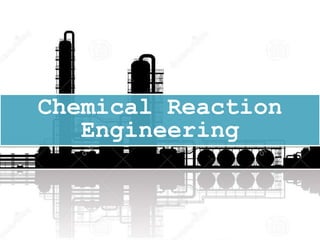
Studies
- 3. • This course is concerned with the rate at which chemical reactions take place, together with the mechanism and rate limiting steps that control the reaction process. • The sizing of chemical reactors to achieve production goals is an important segment. • How materials behave within reactors, both chemically and physically, is significant, as is how the data from chemical reactors should be recorded, processed, and interpreted.
- 4. CSTR • Types Of Reactions 1. Reversible 2.Irreversible • Chemical Reaction • We say that a chemical reaction has taken place when a detectable number of molecules of one or more species have lost their identity and assumed a new form by a change in the kind or number of atoms in the compound and/or by a change in structure or configuration of these atoms. • Note: change in configuration means new things.
- 5. • There are three basic ways a species may lose its chemical identity. 1. Decomposition 2. Combination 3. Isomerization • The rate at which a given chemical reaction proceeds can be expressed in several ways. It can be expressed either as the rate of disappearance of reactants or the rate of formation of products.
- 6. • Rate of reaction for homo the number of moles of chloral reacting (disappearing) per unit time per unit volume (mole/dm^3.s). • For hetero (liquid/solid) the number of moles of A reacted per unit time per unit mass of catalyst (mole/s.g catalyst). • The chemical reaction rate is an intensive quantity and depends on temperature and concentration.
- 10. As define by equation 4.1 will yield a set of differential equations with the fundamental quantities as dependent variables and time as an independent variable. The solution of the differential equation will determine how the fundamental quantities or equivalently the state variables change with i.e. determine the dynamic behavior of the process. If the state variables do not change with time we say the process is a steady state process. In this case the rate of accumulation of the fundamental quantity ‘S’ per unit of time is zero and the resulting balances yield algebraic equations.
- 27. Designing
- 28. DESIGNOFREACTORS
- 30. DESIGNOFREACTORS Answer To The Question On Previous Page
- 45. Know Your Graphs
- 47. • If you want to measure a temperature against mV obtained from the thermocouple you can use this table. Lets say you have a reading 3.8. You look for It in the table and if not found you interpolate amongst two pts. Now the temperature you’re reading it against, take and add in the reference temperature. For example 30 is your reference temperature the your final answer would be 120. 90 + reference temp.
- 49. • This is a psychrometric chart used to calculate humidity in kg/kg from a dry and wet bulb temperatures. Also gives us humid heat and volume in m.^3/kg.
- 50. .043 350 .0065 We use these humidity values to get enthalpy
- 51. .043 350 .0065 PsychrometricChart m1h1 +m2h2 = mh where (m=m1+m2) 300
- 52. • In problem 13.5 from (Chemical Engineering Volume 1, Sixth Edition Fluid Flow, Heat Transfer and Mass Transfer)... • We use this chart to solve it but we first calculate humidity from chart 13.4
- 54. • These are called the pump curves and give us information about the following characteristics of the pump. 1.Pump head 2.Pump efficiency 3.Pump power 4.Pump NPSHR
- 56. • Above is what we call pipe friction tables, basically we get the values of velocity, velocity head and head loss per 100 feet of pipe against a specific flow rate in gallons per minute. • Note: for head loss you must calculate head loss for the feet of pipe YOU HAVE. For example for 50 feet of pipe the head loss against 7 GPM of flow will be 24 cause (48.8/100*50=24 feet). 100 feet of pipe 48.8 feet of head loss We have 50 feet of pipe =24 feet
- 57. Product Name 1.9 Pump Curves This Means that at flow of 2.7 m^3/hour in the product 7 we get a pump head of 1.9 meters.
